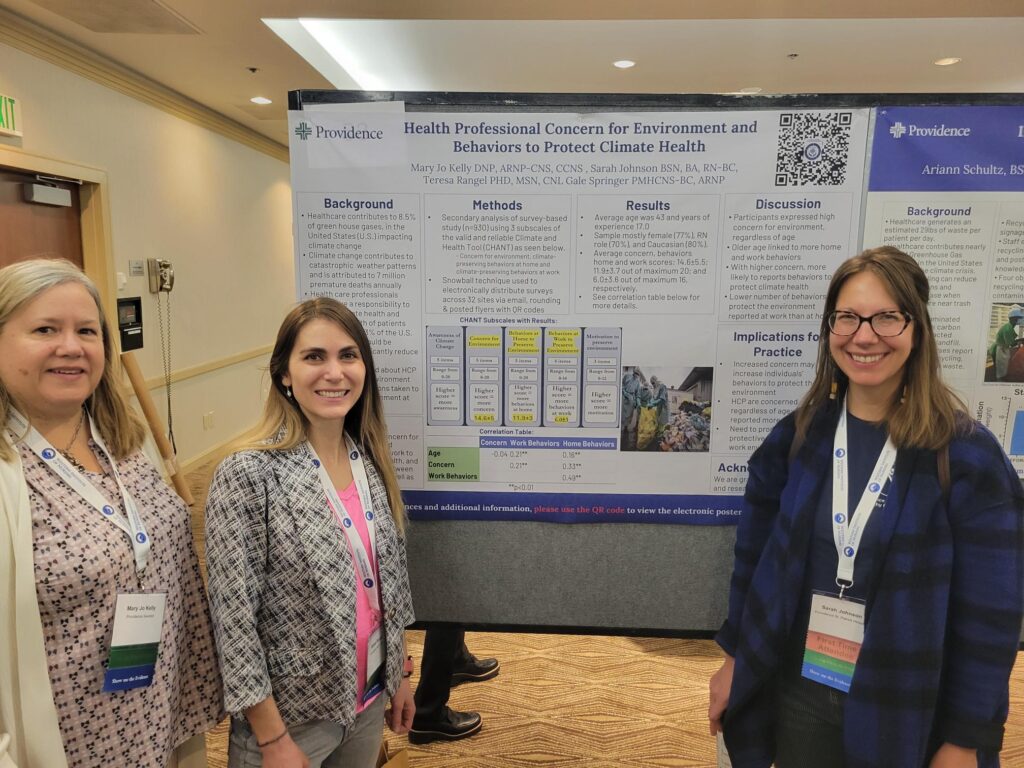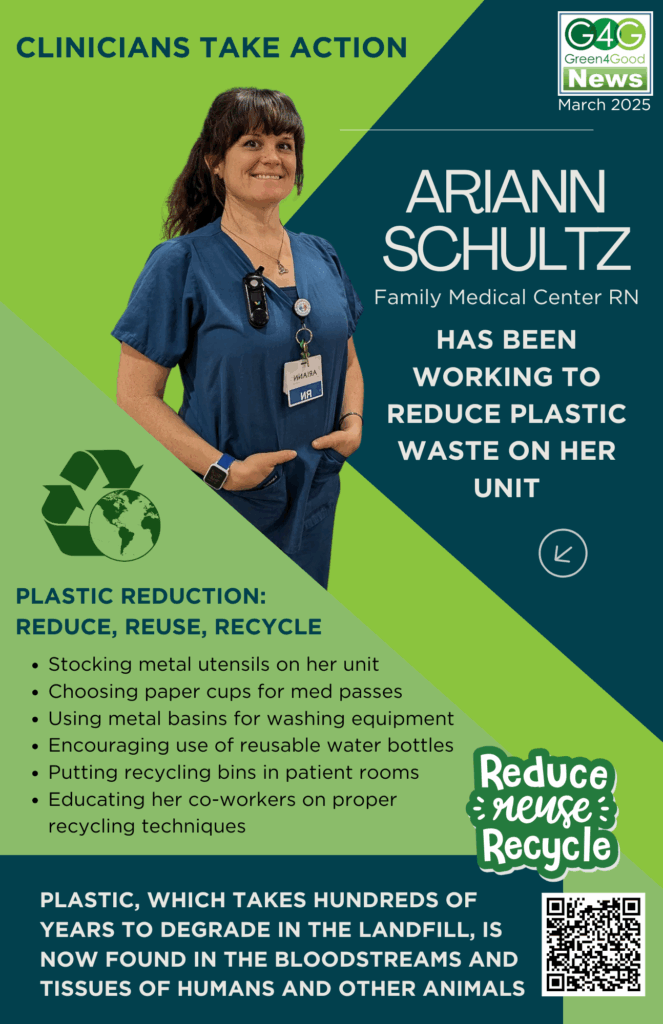Name of Interviewee: Sarah E. Johnson
Organization: Providence St. Patrick Hospital
Initiative Overview
Sarah Johnson led a comprehensive environmental stewardship and climate action initiative at Providence St. Patrick Hospital, a regional acute care facility with approximately 1,300 employees and 600 nurses. The project was a multi-faceted effort to integrate sustainability into the hospital’s nursing operations and broader organizational culture. At its core, the initiative leveraged the Nurses Climate Challenge as a foundational framework while adapting Providence’s system-wide WE ACT model—focusing on Waste, Energy/Water, Agriculture/Food, Chemicals, and Transportation—to fit the hospital’s local context. To ensure lasting impact, sustainability principles were woven into existing structures, including nursing orientations, annual staff skill fairs, and leadership development programs such as the Magnet Council and Clinical Ladder projects. This strategic alignment supported Providence’s ambitious goal of achieving carbon negativity by 2030 while fostering a culture where environmental stewardship became an intrinsic part of nursing practice.
Collaborators
Success hinged on strong collaboration across multiple levels of the organization. The Chief Nursing Officer played a pivotal role by championing the initiative at the executive level, while the Magnet Council provided a governance structure to institutionalize sustainability within nursing practice. Nurses participating in the Clinical Ladder program took ownership of sustainability projects, demonstrating how individual leadership could drive departmental change. The hospital’s Environmental Stewardship team offered critical system-wide resources, including WE ACT scorecards and climate action guidelines. Additionally, the formation of a Green Team and the designation of “Way Shepherds”—nurses who led specific sustainability streams—ensured that efforts were decentralized yet cohesive, empowering staff at all levels to contribute.

Key Stakeholders Engaged
To translate vision into action, the initiative required engagement with a diverse array of stakeholders. Hospital leadership, including the CNO and executive administrators, provided the necessary strategic backing and resources. Staff educators were instrumental in incorporating sustainability into orientation programs and continuing education, ensuring that new and existing nurses were consistently exposed to these principles. The Magnet Council and Professional Governance structures helped embed sustainability into policy and practice, while the facilities and operations teams collaborated on tangible changes, such as optimizing waste streams and reducing energy consumption. External partnerships with organizations like Practice Greenhealth and Healthcare Without Harm brought best practices and external validation to the effort. By framing the work within Providence’s mission of “Mind, Body, Spirit & Planet,” the team underscored the connection between environmental stewardship and health equity, resonating deeply with the hospital’s values-driven culture.
Challenges and Obstacles
Despite its successes, the initiative faced significant hurdles. One of the most pressing challenges was adapting the Nurses Climate Challenge to align with Providence’s internal structures, such as the Magnet program and Clinical Ladder advancement pathways. This required careful localization to ensure sustainability was not perceived as an add-on but as an integrated component of professional development. Compounding this challenge was the low baseline awareness among frontline nurses; internal surveys revealed that only 38.9% were familiar with the WE ACT framework, and a mere 18.8% knew about the system’s carbon-negative commitment. This gap was particularly pronounced among direct care nurses, who comprised 74% of respondents but were less likely to engage with sustainability initiatives compared to their non-direct care counterparts.

Additional obstacles included the relentless clinical demands on nurses, which often relegated sustainability to a secondary priority, and the siloed nature of hospital departments, which hindered cross-functional collaboration. Even among nurses who were aware of the WE ACT framework, translating knowledge into action required persistent education, visible leadership modeling, and institutional reinforcement. To overcome these barriers, the team consistently tied their messaging to Providence’s mission of caring for vulnerable populations, positioning climate action as a critical component of health equity rather than merely an environmental concern.
Results and Impact
The initiative yielded transformative outcomes, both culturally and operationally. Sustainability became a defining element of nursing practice at Providence St. Patrick Hospital, reinforced through orientations, skill-building events, and leadership pathways. The Green Team’s efforts fostered a sense of ownership among nurses, particularly those in leadership roles, who became ambassadors for sustainable practices. Externally, the hospital earned national recognition as one of Practice Greenhealth’s Top 25 Environmental Excellence Award recipients, a testament to its leadership in healthcare sustainability.
On a broader scale, the initiative contributed to Providence’s system-wide achievement of a 12.5% reduction in acute care carbon emissions relative to the 2019 baseline, resulting in annual savings of $11.5 million. Beyond these measurable gains, the project reshaped how nurses viewed their role, expanding it beyond bedside care to include planetary health advocacy. By framing environmental stewardship as integral to “whole-person care”—encompassing mind, body, spirit, and planet—the initiative redefined nursing practice in a way that resonated with Providence’s mission and values.
Advice for Nurses Starting Similar Initiatives
For nurses embarking on sustainability projects, Sarah Johnson offers several key insights. First, she emphasizes the importance of building on existing frameworks, such as the Nurses Climate Challenge or WE ACT, while tailoring them to fit local organizational structures. Securing early buy-in from nursing leadership, particularly the Chief Nursing Officer, is critical to ensuring accountability and resource allocation. Rather than introducing sustainability as an additional burden, she advises embedding it into established processes, such as orientation programs or clinical advancement pathways, to maximize engagement.
Storytelling is another powerful tool; by framing climate action as an extension of nursing’s core values—compassion, justice, and advocacy for vulnerable populations—nurses can connect sustainability to their professional identity. Given the likelihood of low baseline awareness, she stresses the need for targeted education and meeting nurses where they are in their understanding. Creating peer-led groups, such as Green Teams or nurse champion networks, helps sustain momentum, while celebrating small wins keeps morale high. Finally, she encourages nurses to think long-term, viewing sustainability not just as a series of projects but as a cultural shift toward systems thinking and climate-resilient care.
Conclusion
Sarah Johnson’s work at Providence St. Patrick Hospital illustrates the profound impact nurses can have when they lead sustainability initiatives with strategic vision and collaborative execution. By aligning environmental stewardship with organizational values, engaging stakeholders at all levels, and embedding sustainability into existing workflows, her team achieved measurable improvements in both practice and culture. This case study serves as a replicable model for nurses nationwide, demonstrating that sustainability is not just an environmental imperative but a core responsibility of modern healthcare.
Stephanie Santos, a dedicated BSN, RN at Miriam Hospital in Rhode Island, has spent nearly a decade championing environmental sustainability both within her healthcare institution and across her community. Her journey began with a simple observation: the staggering amount of waste generated in patient rooms, where nearly everything was discarded regardless of its condition. This realization propelled her to join the hospital’s green team, where she has since spearheaded initiatives to reduce, reuse, and recycle, while also extending her efforts to community cleanups, advocacy, and education.





